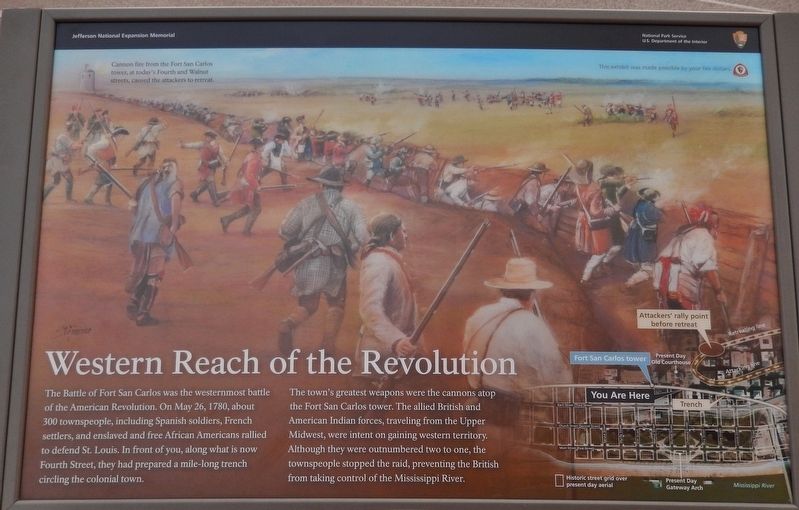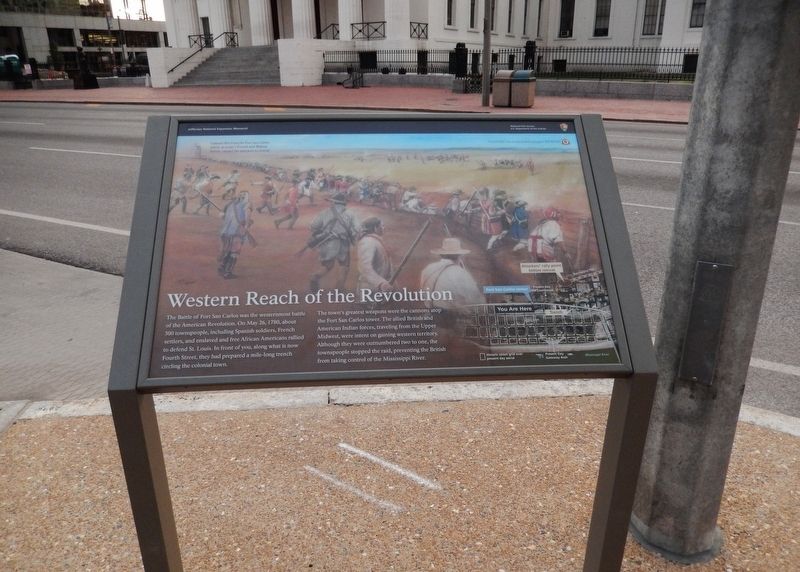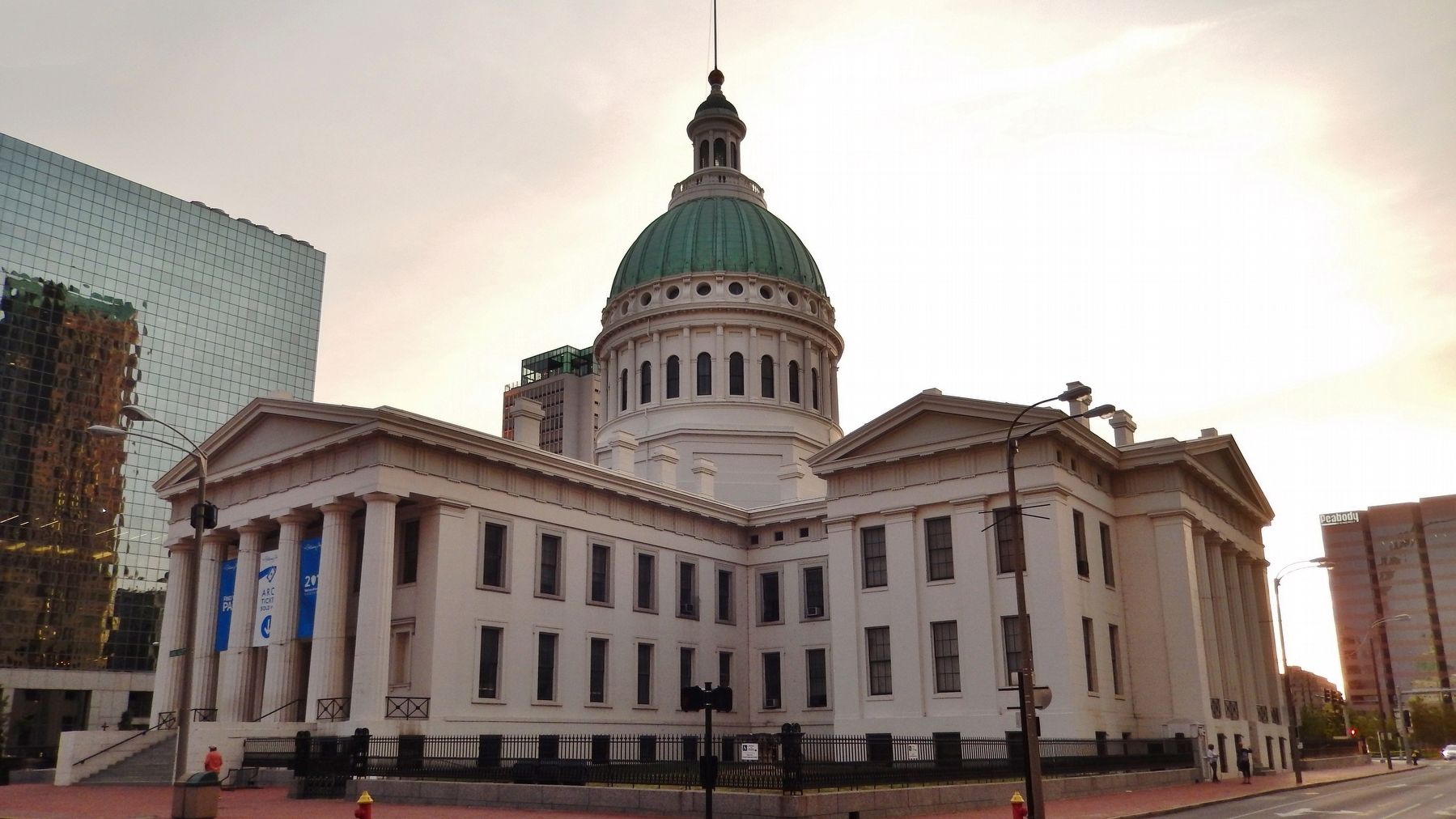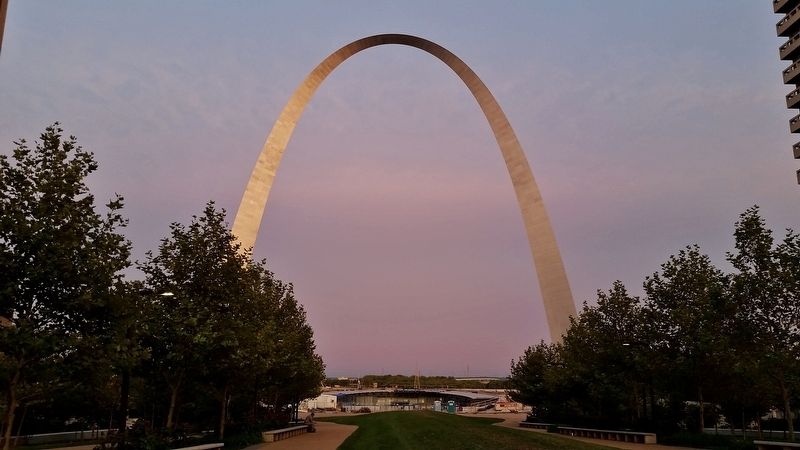Downtown in St. Louis, Missouri — The American Midwest (Upper Plains)
Western Reach of the Revolution
Jeffersion National Expansion Memorial
— National Park Service, U.S. Department of the Interior —
The Battle of Fort San Carlos was the westernmost battle of the American Revolution. On May 26, 1780, about 300 townspeople, including Spanish soldiers, French settlers, and enslaved and free African Americans rallied to defend St. Louis. In front of you, along what is now Fourth Street, they had prepared a mile-long trench circling the colonial town.
The town's greatest weapons were the cannons atop the Fort San Carlos tower. The allied British and American Indian forces, traveling from the Upper Midwest, were intent on gaining western territory. Although they were outnumbered two to one, the townspeople stopped the raid, preventing the British from taking control of the Mississippi River.
Erected by National Park Service U.S. Department of the Interior.
Topics. This historical marker is listed in these topic lists: Native Americans • Settlements & Settlers • War, US Revolutionary. A significant historical date for this entry is May 26, 1780.
Location. 38° 37.543′ N, 90° 11.307′ W. Marker is in St. Louis, Missouri. It is in Downtown. Marker is on North 4th Street south of Chestnut Street, on the right when traveling north. Marker is located on the sidewalk, directly across 4th Street from the Old Saint Louis County Courthouse. Touch for map . Marker is at or near this postal address: 11 North 4th Street, Saint Louis MO 63102, United States of America. Touch for directions.
Other nearby markers. At least 8 other markers are within walking distance of this marker. Joseph Pulitzer (within shouting distance of this marker); The Old Courthouse (within shouting distance of this marker); Dred and Harriet Scott (within shouting distance of this marker); Sold on the Steps of Justice (within shouting distance of this marker); International Fur Exchange (within shouting distance of this marker); Abraham Lincoln Slept Here (about 300 feet away, measured in a direct line); KMOX (about 300 feet away); Site of the Democratic National Convention of 1876 (about 300 feet away). Touch for a list and map of all markers in St. Louis.
Also see . . .
1. The Battle of Fort San Carlos. In 1780, on what is now the corner of Walnut and 4th Streets, St. Louis staged the only battle in the American Revolution fought west of the Mississippi River. Even more interesting is that it wasn’t very “American” at all. The kingdoms of Spain and Great Britain were the belligerents. To mix it up further, the Spanish force consisted mainly of French creoles and slaves. The British force was overwhelmingly Indian, with a sprinkling of Canadian hunters and British regulars thrown in. Remarkably, these two
patchwork armies went about trying to kill each other over a small fur-trading village that wouldn’t become part of the United States for another twenty-four years. (Submitted on June 20, 2018, by Cosmos Mariner of Cape Canaveral, Florida.)
2. St. Louis History: Battle of Fort San Carlos. St. Louis, in 1780, was a Spanish Colony and under the leadership of Spanish Lieutenant Governor, Fernando DeLeyba. As the American Revolution began heating up, particularly after the French became open allies of the Americans in 1778, the Spanish began to provide covert aid and supplies to the English colonists. DeLeyba, fearing British reprisals, urged that four stone towers be built to protect St. Louis. At the top of the hill, near where the Old Courthouse exists today, the first of the towers, called Fort San Carlos was built in April, 1780 and a trench was dug around the town. On May 26, 1780, between 1,300 and 2,000 British-led Sioux, Sac, Fox and Winnebago warriors suddenly fell upon the unsuspecting community of 900 people. The Indians killed several settlers and slaves who were tending their fields on the outskirts of town. The firing alerted St. Louis’s militia, who ran to the barely-completed entrenchments. The attackers were hit with a withering fire from militia musketry. But it was the cannon placed in the tower called Fort San Carlos that repelled the attack. (Submitted on June 20, 2018, by Cosmos Mariner of Cape Canaveral, Florida.)
3. Battle of St. Louis. The village lost between 50 and 100 people who were either killed, wounded or captured. Virtually all casualties were civilians. DeLeyba died the following month. He was the subject of local criticism because he never formally recognized the efforts made by the citizenry in the town's defense. King Charles did not know he had died and promoted him to lieutenant colonel because of his valor in action. The site where Fort San Carlos stood is at the corner of Fourth and Walnut Street in St. Louis. A local organization commemorates the event by reading out the names of the 21 people who lost their lives during the battle. The battle is also remembered in a mural and diorama located in the Missouri State Capitol. (Submitted on June 20, 2018, by Cosmos Mariner of Cape Canaveral, Florida.)
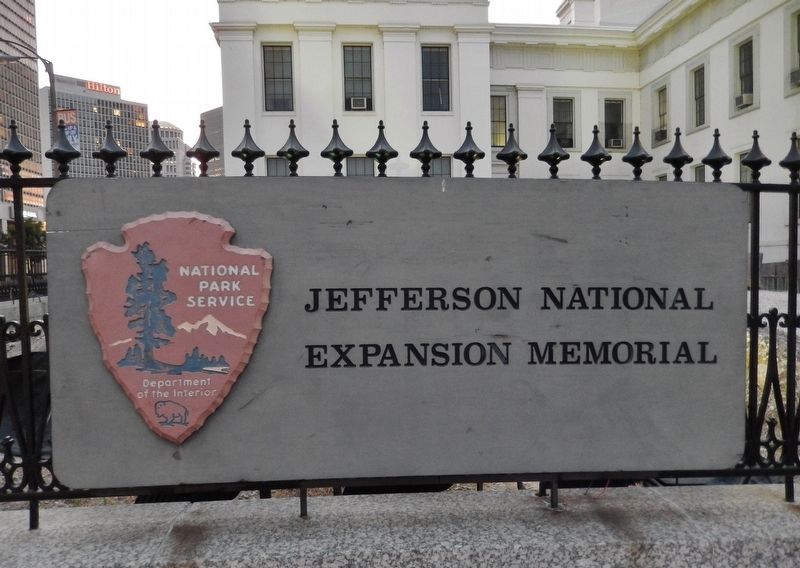
Photographed By Cosmos Mariner, September 11, 2017
4. Jefferson National Expansion Memorial Sign (near marker)
The Old Saint Louis County Courthouse and grounds, as well as the Gateway Arch and surrounding grounds, are part of the Jefferson National Expansion Memorial, and managed by the United States National Park Service.
Credits. This page was last revised on January 30, 2023. It was originally submitted on June 20, 2018, by Cosmos Mariner of Cape Canaveral, Florida. This page has been viewed 388 times since then and 31 times this year. Photos: 1, 2, 3, 4, 5. submitted on June 20, 2018, by Cosmos Mariner of Cape Canaveral, Florida. • Bill Pfingsten was the editor who published this page.
